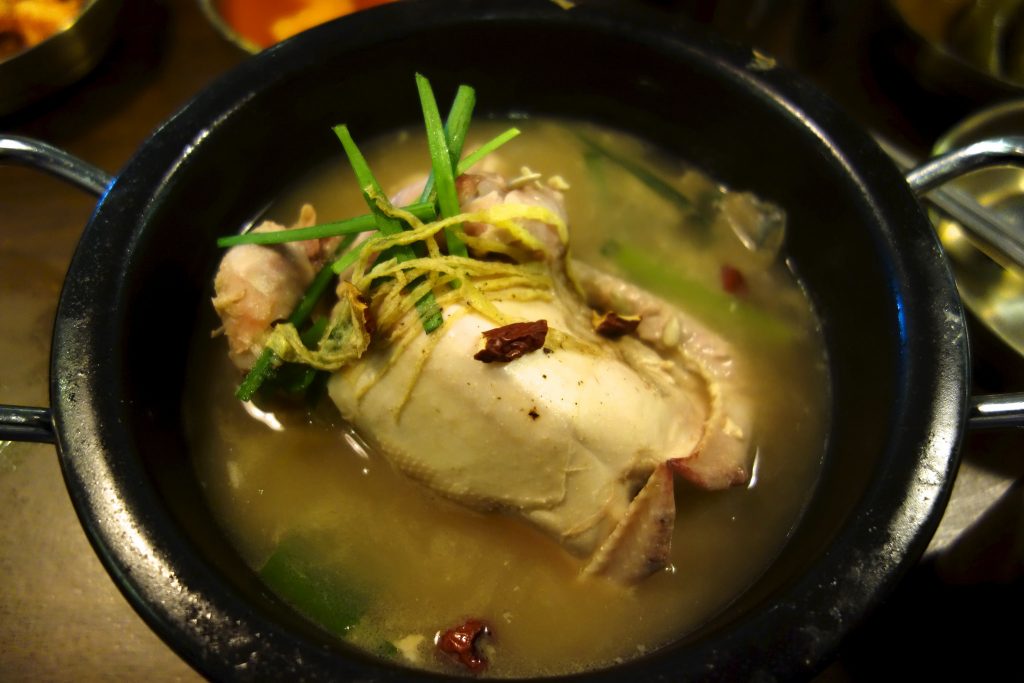Samgyetang: Korean cuisine’s cure-all chicken soup Posted by Tony Kitchen on Mar 20, 2014 in Uncategorized
Long before the Western tradition of Campbell’s Chicken Soup as a cure for sickness, the Korean version was a prevention, cure, and a summertime rejuvenation dish. It’s bone-in chicken method with sticky rice, ginseng, jujubes, and garlic is a gigantic bowl of Korean comfort food that must be exported.
For its medicinal benefits and traditional herbal additives, the soup is generally considered a summertime meal served hot and meant to replace the lost energy and vitamins taken by the summer heat. But the preventive and curative ginseng, along with the “stick-to-your-ribs” feel, makes it a year-round soup.
Samgyetang (삼계탕), the Korean ginseng chicken soup, is typically made with a young chicken (under 50 days old) stuffed with rice (밥), peeled chestnuts (깐밤), and jujubes (대추), or Korean dates. It’s then boiled in a ginseng (인삼) broth. (The highest form of samgyetang, in my humble opinion, uses ginseng aged roughly 3-5 years, which should come from Geumsan (금산), the town famous for its ginseng.) What is added in the broth is what separates a standard samgyetang from an exceptional one. The general mix of salt (소금), pepper (후추), whole garlic (통마늘), and green onions (파) is the standard. However, each recipe has medicinal additives which can separate it from the competition: gingko nut, milkvetch root (황기) and wolfberry (구기).
The soup is most popular in the summer when the combination of heat and monsoon rains can make it hard to keep moving. Sambok (삼복), the Korean word for the three hottest days of the year falling between July and August, and the downpours of rain in June keep samgyetang restaurants in Korea packed. (Personally, eating samgyetang regularly in the winter kept me free of any illness or cured me in a much shorter time than any pharmaceutical.) Most restaurants that serve samgyetang serve only just that, making a long-lasting business on a secret, generational recipe. On top of serving the roughly $10 soup, restaurants will offer a small complimentary bottle of insangju, ginseng alcohol (인상주). As is the case with most ginseng-based foods in Korea, it’s also meant to strongly boost physical and sexual stamina.
Samgyetang is not a quick meal either. The chicken is whole, and there is a bit of separation to be done. A large stone pot is served along side a smaller bowl with a ladle. The ladle is meant to scoop small servings into the bowl, or to separate the bones from the soup. It’s served with the traditional side dishes (반찬) and garlic sauteed chicken gizzards (딹똥집) (usually misidentified as chicken rectum).
For Koreans who are heavy on traditional medicine, the health benefits are obvious for them. The Chosun Ilbo, a Korean newspaper, reported that: “According to oriental medicine guides, garlic detoxifies the body, jujube quenches thirst, and ginkgo nut protects lungs that are apt to be weakened by low energy levels. All of these ingredients are then cooked with chicken, rich in protein and essential amino acids.”
For foreigners in Korea, the food hasn’t been ignored. An online straw poll by the Seoul Metropolitan Government of nearly 2,000 foreigners rated samgyetang as the fifth most popular food, falling behind the staples of samgyupsal (삼겹살), kimchi (김치), ddeokbokki (떡볶이), and bibimbop (비빔밥).
At roughly 800 calories, 52 grams of fat, and 55 grams of protein, the meal is dense, more of a sparse ailment cure than a regular stop. It’s much more common and feasible to go out, rather than cook it at home. (However, you can find a recipe and detailed instructions here.)
Beyond the medicinal benefits, the food deserves a more international presence in foreign Korean restaurants, even if it’s not served in its traditional big bowl. Regardless of one’s health, samgyetang’s presence should not be confined to sweaty Koreans hovering over a bowl in the summer heat. It deserves to be an international cuisine.

Build vocabulary, practice pronunciation, and more with Transparent Language Online. Available anytime, anywhere, on any device.




